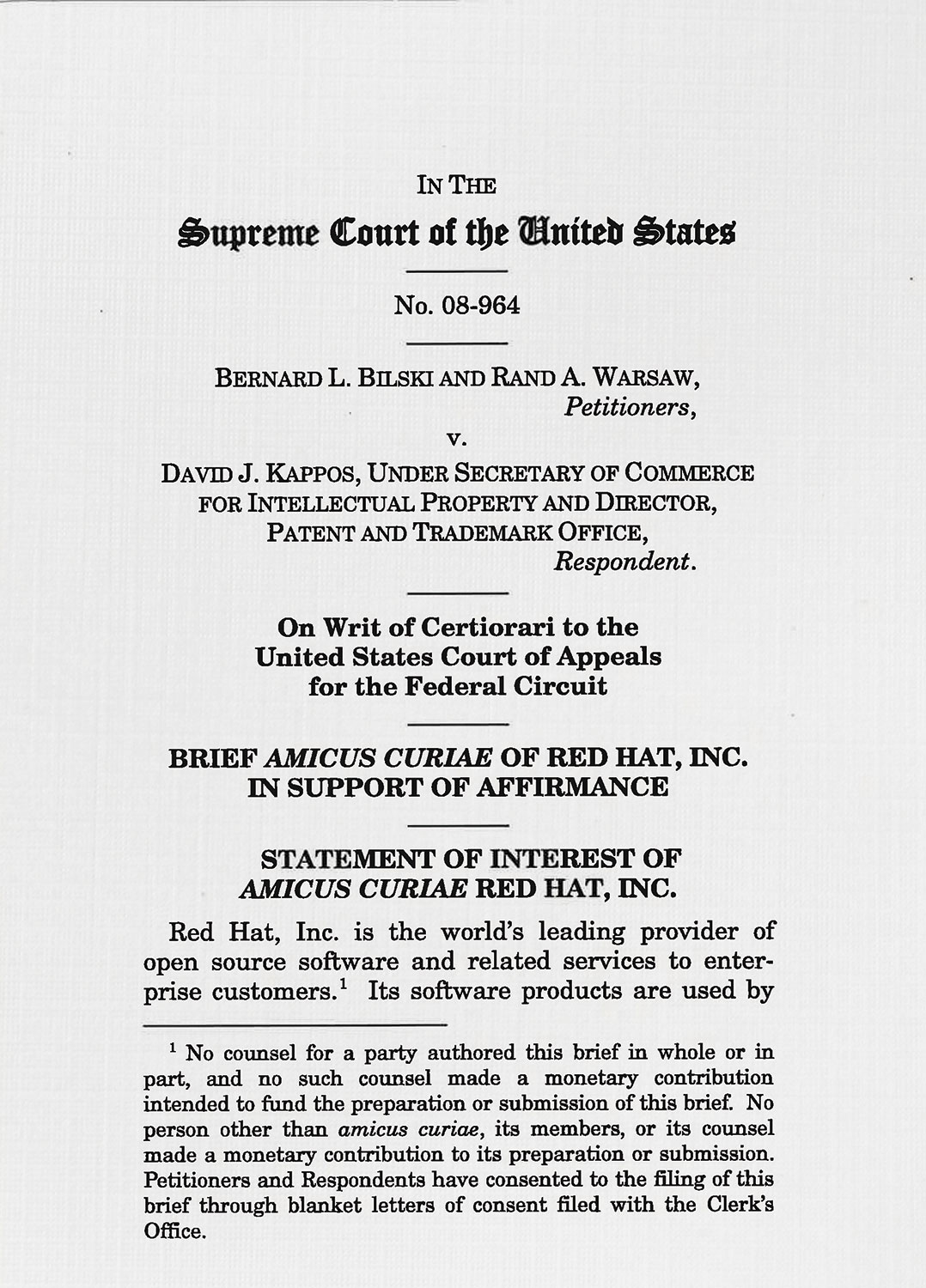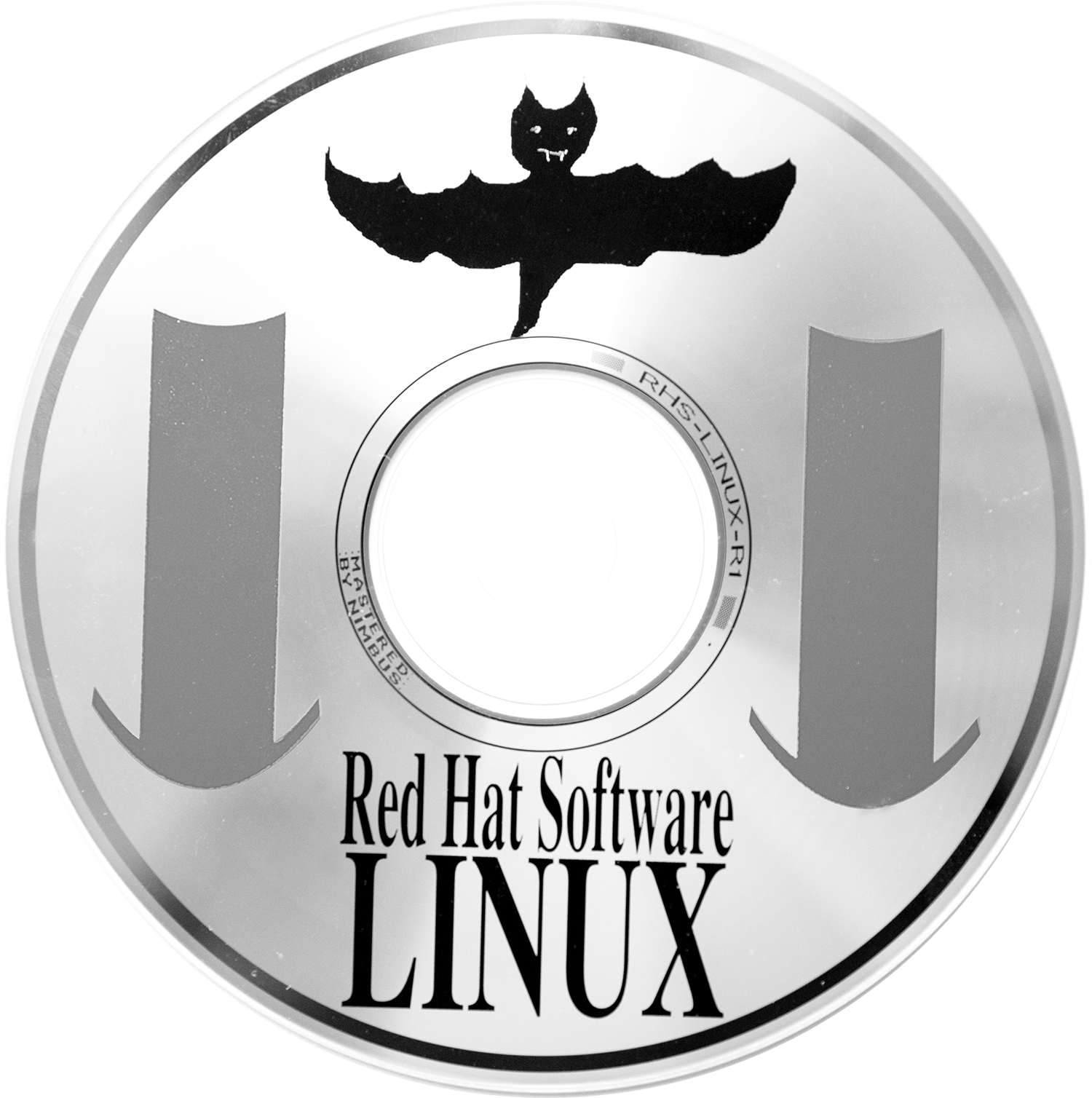Red Hat connects enterprises seeking open source solutions with the communities that create those solutions.
Customers rely on Red Hat as their guide to a fast-moving ecosystem of open source innovation. Red Hat helps them participate in that ecosystem—so they needn’t risk going it alone.
Red Hat is guided by an essential truth: Sharing is better, more productive, and ultimately more enriching than hoarding.
This wasn’t always a popular view in the software industry. Others were skeptical—even dismissive. But we built a profitable company by catalyzing, compounding, and releasing creative force rather than capturing it.

…to share knowledge and build upon each other’s discoveries.
…to solve complex problems by bringing passionate people together to collaborate.
…to create communities where everyone is fully supported to use their voices and talents to contribute.
“Far from encouraging innovation,
vague software patents discourage
it. The problem of vagueness is so
endemic in software patents that it
warrants action at the threshold level
of subject matter eligibility.”
Brief Amicus Curiae of Red Hat, Inc. submitted to the Supreme Court of the United States in the case of Bernard L. Bilski and Randa A. Warsaw v. David J. Kappos
In court and public policy, Red Hat is a clear voice against those who wish to restrain open source.
In 2003, before we developed our current mission statement, we had
a guiding principle. We called it our “raison d’être” or “reason for being”.
This was a bold statement, more vision than mission.
It showed the scale of our ambition—to be the defining technology company of the 21st century. It spoke to our love of openness and of the hope that both our technology and our company could act as liberating and progressive forces.
But it didn’t say what we should or would do. It made no concrete promises. It was an aspiration, not a plan of action.
So it became our vision statement, and it still is today.
By 2009, we needed to make a concrete, coherent statement about who we were, why we existed, and what we were going to do about it.
A new mission statement could never be handed down from the boardroom. Something this important would have to emerge from a deliberate, participatory process. So we came together as a company and collectively wrote a new mission statement—more than 400 Red Hatters participated in drafting it.
The result is what you see today.

It was a red Cornell lacrosse cap, and it belonged to Marc Ewing, one of Red Hat’s co-founders.
Marc wore his grandfather’s red hat while working in the computer lab at Carnegie Mellon, helping fellow students.
Marc was well-known for his competence and willingness to share his knowledge and expertise.
“If you need help, look for the guy in the red hat,” people would say.
When Marc started distributing his personally curated version of Linux®, he named it Red Hat.

Marc did not know it at the time, but red hats have historically been symbols of emancipation, liberty, and freedom.
Freed Roman slaves wore them during their emancipation ceremony. The bonnet rouge became a symbol of liberty during the French Revolution.
Many soldiers in the American Revolution wore red knitted stocking caps. Even today, the red hat is a symbol of freedom in the flags or seals of many states and nations.
Today, the official Red Hat fedora represents freedom of a different sort: the freedom to connect, form communities, and share code.
This is the red hat of the information revolution.
Every movement needs a symbol—ours is the red hat of the information revolution.
“The best analogy that illustrates this benefit is with the way we buy cars. Just ask the question, ‘Would you buy a car with the hood welded shut?’ and we all answer an emphatic ‘No.’ So ask the follow-up question, ‘What do you know about modern internal-combustion engines?’ and the answer for most of us is, ‘Not much.’
“We demand the ability to open the hood of our cars because it gives us, the consumer, control over the product we’ve bought and takes it away from the vendor. We can take the car back to the dealer; if he does a good job, doesn’t overcharge us, and adds the features we need, we may keep taking it back to that dealer. But if he overcharges us, won’t fix the problem, or refuses to install that musical horn we always wanted—well, there are 10,000 other car repair companies that would be happy to have our business.
“In the proprietary software business, the customer has no control over the technology he is building his business around. If his vendor overcharges him, refuses to fix the bug that causes his system to crash, or chooses not to introduce the feature that the customer needs, the customer has no choice. This lack of control results in high cost, low reliability, and lots of frustration.”
Bob Young
Open source is here to stay. ZDNet, May 2000. zdnet.com/article/open-source-is-here-to-stay

For many years, Red Hat Linux was a boxed product, sold alongside copies of Microsoft Windows and Lotus Notes in retail stores. Before downloading an entire operating system was practical, we burned it onto CDs, which were then packed and shrink-wrapped, loaded on trucks, and sent to stores.
When we said “ship it,” we meant it literally.
Typically, a new version of Red Hat Linux was released every six months or so. In that way, Red Hat resembled every other software company—hoping customers would buy a new version every few months to get new features. We also made a little money on the side selling hats, t-shirts, and stickers.
Our open source development model was innovative, but our distribution and business models were conventional.


Red Hat Linux was distributed on CDs and sold in retail stores.
Enthusiastic early adopters with a strong do-it-yourself spirit occasionally used the retail-box version of Red Hat Linux in business.
But larger enterprises would never update their systems every six months. They expected 24x7 support. They needed testing and certification from hardware providers. They wanted enterprise applications from independent software vendors that were certified to run Red Hat solutions. And the cost of migrating had to be low enough—and the benefits pronounced enough—that it was worth the effort.
If Red Hat was going to step up to the opportunity of offering enterprise open source technology, we had to envision a new business model. In order to succeed, Red Hat had to change quickly and dramatically.
In 2002, we took a leap of faith.
We ceased distribution of Red Hat Linux, our boxed flagship product and the sole source of our revenue (other than the t-shirts and stickers, of course). In its place, we introduced an enterprise edition—and sold it on a subscription basis.
The decision to launch Red Hat Enterprise Linux was controversial. Even inside Red Hat, it wasn’t universally understood or accepted. People at every level challenged it.
Making the case was hard work.
Red Hatters were free to say anything they liked, both in meetings and on our companywide email list. The decision was proposed, discussed, and debated openly. And people were held accountable—not for having the audacity to criticize or challenge leadership, but for the quality and merit of their arguments. No one ever gets fired from Red Hat for challenging leaders’ ideas, but everyone understands that the best way to make a difference is to have stronger ideas and to advocate for them.
Over time, everyone began to feel some ownership over the decision to introduce Red Hat Enterprise Linux. The dissent and agreement had coalesced to strengthen the plan, and this made it easier to tackle the technical, legal, and business challenges that plan would introduce. Now everyone felt responsible for its success.
This collaborative and inclusive experience was the origin of what we now call the Open Decision Framework, Red Hat’s process for making decisions the open source way.
In the end, Red Hat created Fedora, the freely available, community version of our Linux operating system.
Today, Red Hat engineers collaborate with thousands of contributors to keep Fedora free. It’s our promise to the future of Linux.
Red Hat Enterprise Linux became our flagship product, our offering to the world’s most demanding datacenters.
It has led to more than a decade of steady growth and allowed us the resources and flexibility to participate in many other open source communities. As these communities crafted new technologies, our portfolio expanded. Today, Red Hat offers open source solutions for application development, virtualization, storage, cloud computing, and containers. Our participation in forward-looking open source communities fuels our insight into the future. It helps us know—and show our customers—which technological developments have the potential to change the world.
Confronted by a changing market and faced with an existential threat, we applied open source principles, debated fiercely, adapted collectively, and built an entirely new Red Hat.
That passion for pragmatic renewal is hardwired into Red Hat. It’s one aspect of being an open source company that has been so advantageous to us over the past three decades.
Open. Old English, of Germanic origin; related to Dutch open and German offen, from the root of the adverb up.
“Creating better technology the open source way”—that phrase from our mission statement says something special about our organization. Other companies might claim to “create better open source technologies.” We do that and more. We “create better technologies the open source way.”
“Open” describes not just what we make but how we make it—and our open methods distinguish us from everyone else.
We focus on putting the right people in touch with one another so that they can share ideas and information. Instead of prescribing, we enable. Instead of executing on top-down plans, we engage with one another to realize shared goals. We don’t rely on a small cadre of internal experts to chart our path; instead, we broaden our pool of innovation to include everyone with a stake—partners, customers, and communities—so that we are able to respond to needs and opportunities more quickly and connect projects with the resources and talent they need to realize their promise.
Working the open source way has always been a competitive advantage for Red Hat. It helps us respond quickly when the market changes. It keeps us accountable to our colleagues and our communities. It enlivens our workplaces, making them more engaging and empowering. It aids us in recruiting and retaining the most talented people. And it means we’re a unique ally to customers facing challenges that demand an open approach.
Technology. Early 17th century: from Greek tekhnologia ‘systematic treatment’, from tekhnē ‘art, craft’ + -logia (see-logy).
The term “open source” refers to something people can modify and share because its design is publicly accessible.
Traditionally, the word “source” in “open source” referred to the term “source code.” Source code is what computer programmers use to create software. It’s invisible to most users. When source code is “open”—open to review, open to revision, open to enhancement—people other than a program’s creator can view and manipulate that code. Anyone can improve it.
Today, “open source” designates something much broader: an ethos or ethic that guides the way people make things together. We call it the open source way.
Working the open source way means collaborating with others by default, sharing wisdom and resources unsparingly, and ensuring the best solutions to difficult problems endure as common knowledge.
Open source is an attitude, not just a methodology.
Rapid prototypes can lead to rapid discoveries. An iterative approach leads to better solutions faster. When you’re free to experiment, you can look at problems in new ways and seek answers in new places. You can learn by doing.
Whether we’re developing software or solving a business problem, we all have access to the information and materials necessary for doing our best work. And when these materials are accessible, we can build upon each other’s ideas and discoveries. We can make more effective decisions and understand how decisions affect us.
When we’re free to participate, we can enhance each other’s work in unanticipated ways. When we can modify what others have shared, we unlock new possibilities. By initiating new projects together, we can solve problems that no one can solve alone. And when we implement open standards, we enable others to contribute in the future.
Good ideas can come from anywhere, and the best ideas should win. Only by including diverse perspectives in our conversations can we be certain we’ve identified the best ideas, and decision-makers continually seek those perspectives. We may not operate by consensus, but successful work determines which projects gather support and effort from the community.
Communities form when different people unite around a common purpose. Shared values guide decision making, and community goals supersede individual interests and agendas.

The open source model depends on a free exchange of opinions and ideas. This forms the foundation for positive change.
Expressing freedom takes courage. So does challenging some of the world’s most domineering companies.
There is a Japanese proverb that says, “Fall seven times, stand up eight.” Commitment is staying fixed to our goals and seeing things through.
To our customers. To our stakeholders. To the community. And to each other. Forget this and we lose our freedom.
The same is true for our mission and our brand. We serve our enterprise customers. We serve the community. We serve our shareholders. All are related. None can be ignored.
While this keeps Red Hat in a state of constant change— the balance is always shifting and righting itself—it also firmly roots us to a greater purpose.

As a company, we are like a ship that rights itself when we lean too heavily in the direction of any one of these four values. It isn’t always easy for people who naturally gravitate toward freedom or courage to work with those who lean more toward accountability or commitment. The inherent tension and conflict between our values is part of what makes them so compelling, and as Red Hatters, it’s up to all of us to hold each other accountable for keeping the four values in balance.
“People come to work at Red Hat for our brand, but they stay for the people and the culture. It’s integral to our success as an organization. It’s what makes the experience of being a Red Hatter and working with other Red Hatters different. And it’s what makes us so passionate about our customers’ and Red Hat’s success.”
DeLisa Alexander
Red Hat is an incorporation of open source ideals. And those ideals are our competitive advantage.
All customer and stakeholder value grows out of the technology, expertise, and wisdom we gain from being a part of the open source ecosystem.
Red Hat benefits from open source projects, but our relationship to them is reciprocal. We are catalysts and a potent creative force in the open source technology ecosystem. We cultivate innovative communities, nurture collaborative environments, and, when necessary, protect our technology ecosystem as a whole.
We do this because we know that the best way for us to win is to create more winners. And we create more winners by joining and contributing directly to open source community projects, acquiring useful proprietary code and liberating it, and by fighting for the legal right to share and collaborate.
If it helps our customers and makes open source stronger, we do it.
In 2015, Jim Whitehurst published The Open Organization. The book chronicles his professional transition from COO at Delta Air Lines, a conventionally run organization, to CEO of Red Hat, an open one. Jim’s experience caused him to fundamentally rethink what he knew about what makes organizations succeed: “This company changed me and taught me how to be a better leader.”
Jim’s name is on the book’s cover, but several people—some whom had been at the company longer than he had—contributed to it. Like everything else at Red Hat, The Open Organization was a collaborative effort.
And just as we share our open code, we also share our knowledge about the ways open source principles can form the foundation of a more dynamic, engaging, and innovative organizational culture. A global community of readers continues to extend and refine Jim’s thinking on the future of management and leadership—and The Open Organization has grown into a multi-book series featuring dozens of authors.
Red Hat recognized the truth about open source software development well before the idea itself was proven true.
Red Hat demonstrated the power of that open, self-organizing collaboration as a long-term way to create a shared commons of expertise and technology that levels the playing field and enriches all participants.
Sharing knowledge and expertise, a technique for survival and enrichment that had been practiced for all of human history, applied to modern commercial software development changed technology, and the technology industry, forever.
Red Hat stands on the shoulders of giants, and truth happens.
William James
American philosopher and psychologist
Futurists will tell you that imagining the future is not a solitary endeavor. Too many variables—climate, politics, migration, accidental discoveries, and tragic accidents—make perfect prediction impossible. No one has an imagination that rich.
The same is true of technology. No single company nor visionary genius has a completely accurate map of the future.
But the most accurate vision of the future is a collective one. Open, free, carefully debated, and crafted in good faith.
When enterprises, academics, governments, and technologists combine their visions, the obstacles that stand in our way become clearer. And so do the promising beacons of innovation on the horizon.
Intersecting interests and good communication guide the way. With more eyes, all bugs are shallow. With more eyes, we see more of what lies ahead.
Standing on the shoulders of giants will let you see further. But you’re still only seeing one point of view from one moment in time. Looking ahead together—and sharing what we see—is how we will know where to go.
See our story unfold in your inbox. We'll send you relevant emails, and not too often.
Update your email preferences and contact details any time.
